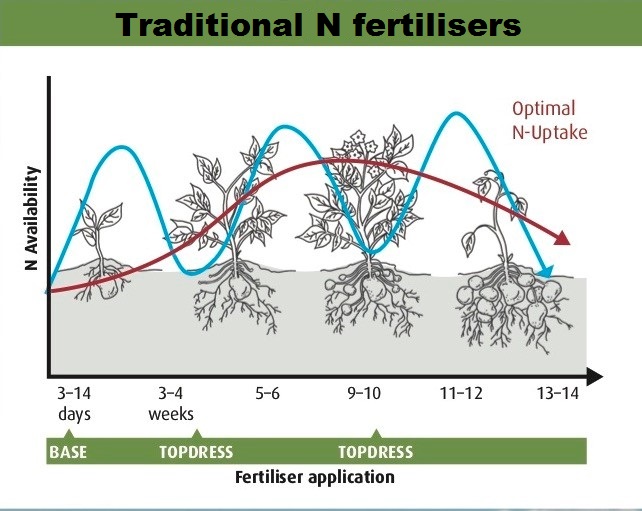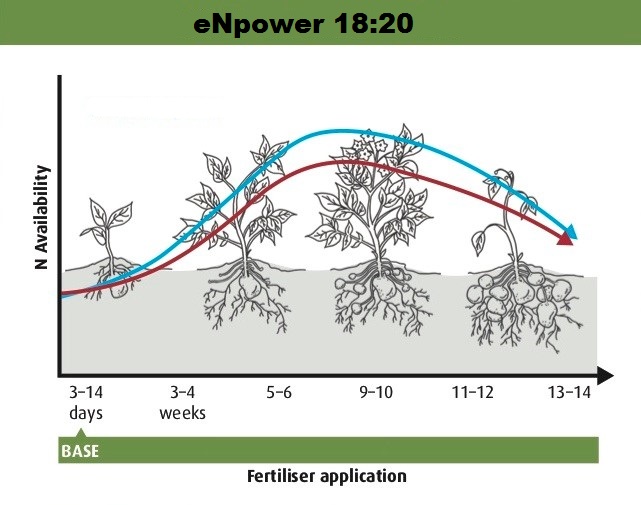Power up your planting blends
Oct 10, 2019Incitec Pivot Fertilisers is introducing a powerful addition to DAP that will help growers keep the nitrogen where it’s needed for longer, drive phosphorus uptake and potentially improve crop yields and quality. Our new product, eNpower 18:20, is DAP coated with a patented new formulation ammonium stabiliser, DMPG.

Click here to download this article
It works just like ENTEC®, by inhibiting the nitrifying bacteria in the soil which convert ammonium nitrogen to nitrate nitrogen. If you’ve had experience with ENTEC, you’ll know the advantages this can bring. It can mean better nitrogen efficiency, reduced losses from leaching, runoff and denitrification, better protection in the wet and a nitrogen supply that better matches crop demand.
Nitrogen losses can have a significant impact on crop production systems. Lost nitrogen does not contribute to crop production and is detrimental to the environment.
Incitec Pivot Fertilisers developed the new formulation ammonium stabiliser because DAP and ENTEC were not chemically compatible. DAP is a key planting fertiliser for potatoes and a range of other temperate crops, so this is an important step towards better outcomes for more growers.
By using eNpowerTM 18:20, growers can improve their fertiliser efficiency using current equipment. It may reduce on-farm labour by reducing the number of extra applications, increase flexibility for application timings and help growers avoid missed windows of opportunity for fertiliser applications.
Matching nitrogen supply with crop demand
The best fertiliser programs match nutrient supply with crop demand to avoid over and under application and to help crop growth progress towards optimum yields and quality. This is easier said than done!
Potatoes, for example, require most of their nitrogen from tuber initiation (30-40 days post planting) to late tuber bulking (90 days post planting). When using traditional fertiliser programs, a large amount of nitrate nitrogen is available in the soil well ahead of when it is needed by the crop and this is then topped up with one or two side dress applications. This potentially creates waves of nitrate nitrogen excess and deficiency throughout the season. See Figure 1. Too many passes across the paddock can result in compaction or crop damage, as well as increasing fuel and labour costs.



Figure 1: Using eNpower 18:20 for the basal application helps provide a more continuous supply of nitrogen to the crop and may reduce the need for top up applications.
Using eNpower 18:20 provides an alternative for growers looking to better match nitrogen supply with crop demand by keeping the nitrogen in the soil in the ammonium form for a number of weeks. This prevents nitrate leaching and denitrification.
Nitrate leaching occurs when nitrates move down through the soil profile beyond the root zone. Leaching losses can be significant, particularly on lighter soil types with a cation exchange capacity (CEC) of 4 or less. Denitrification occurs where soil oxygen has been depleted in high soil moisture situations, and results in the loss of nitrogen to the atmosphere.
Ammonium nitrogen is positively charged and sticks to the soil, so that plants and the soil compete for ammonium nitrogen.2 Therefore, it not subject to leaching. Ammonium is not subject to any denitrification losses either.
Most crops, including potatoes, are able to take up ammonium nitrogen, so there is no delay in nitrogen availability. In fact, eNpower 18:20 could help promote quality and consistency in produce in crops such as broccoli, potato, sweet corn or lettuce by reducing the incidence of nitrate flushes.
Using eNpower 18:20 is a good way to set crops up for success, whatever the season. Australia’s horticultural regions are subject to unpredictable rainfall, and while good rains can lead to good yields, they can also rob the crop of nitrogen. Using eNpower 18:20 helps protect nutrients for when the crop needs them most.
Driving phosphorus uptake
Phosphorus is essential for photosynthesis, plant growth and crop development and is the most expensive macro nutrient. Switching from DAP to eNpower 18:20 has the potential to increase the uptake of phosphorus by two mechanisms.
Firstly, phosphorus uptake is strengthened when crops take up ammonium nitrogen rather than nitrate nitrogen. As the plants absorb the positively charged ammonium nitrogen, they naturally compensate by seeking out negatively charged nutrients such as orthophosphate (phosphorus). This effect can give crops a better start.
Secondly, the use of ammonium stabilisers promotes rhizosphere acidification, via a process referred to as partial ammonium nutrition. The rhizosphere is the specific zone immediately around each plant root (generally within 1 mm distance). Ammonium stabilisers make only the rhizosphere slightly more acidic while the DMPG is active. This ‘very localised’ change to pH improves phosphorus and zinc availability. See Table 1. Rhizosphere influences, of which rhizosphere acidification is one example, can greatly benefit crop production.
Table 1: Influence of the nitrogen form on uptake of other nutrients
|
|
pH value |
Nutrient uptake (µg/m root length) |
||||||
|
|
Root distance |
Rhizosphere |
P |
Fe |
Mn |
Zn |
Cu |
K |
|
Nitrate |
6.6 |
6.6 |
123 |
55 |
8 |
7 |
1.4 |
903 |
|
Ammonium |
5.7 |
5.6 |
342 |
71 |
20 |
13 |
2.0 |
1127 |
|
Ammonium with N inhibitor |
6.6 |
4.5 |
586 |
166 |
35 |
19 |
4.6 |
1080 |
The nitty gritty
As with ENTEC, eNpower 18:20 will only be available from accredited advisers who have proven their understanding of the product by satisfactorily completing a training course and assessment. This helps ensure the best practice use of eNpower 18:20 for the best possible results in crop.
Growers can buy eNpower 18:20 as a straight or in blends. As with any fertiliser decision, it should be based on a sound understanding of the soil nutrient status and the requirements of the crop. Always arrange soil testing and analysis through the Nutrient Advantage® laboratory to determine an appropriate fertiliser strategy.
In Incitec Pivot Fertilisers’ incubation trials, the DMPG ammonium stabiliser has been shown to be effective on other nitrogen fertilisers present in blends with eNpower 18:20. However, to ensure the ammonium stabiliser works effectively in a blend, eNpower 18:20 must provide at least 50% of the total nitrogen in the blend.
To find out more about eNpower 18:20, read the eNpower 18:20 brochure or contact me on 0466 664 026 or conrad.leeks@incitecpivot.com.au.
References:
1 Trenkle, M. (2010). Slow-and Controlled-Release and Stabilized Fertilisers. An option for Enhancing Nutrietn Use Efficiency in Agriculture. International Fertilizer Industry Association. Second edition.
2 Amberger, A. (1996): Pflanzenernahrung (Plant Nutrition). 4th Edition. (German) Uni-Taschenbucher 846, Verlag Eugen Ulmer, Stuttgart, Germany.
TM eNPower is a trademark of Incitec Pivot Limited. ®ENTEC is a registered trademark of EuroChem Agro GmbH. ®Nutrient Advantage is a registered trademark of Incitec Pivot Limited. This is a guide only, which we hope you find useful as a general tool. While Incitec Pivot Fertilisers has taken all reasonable care in the preparation of this guide, it should not be relied on as a substitute for tailored professional advice and Incitec Pivot Fertilisers accepts no liability in connection with this guide.
